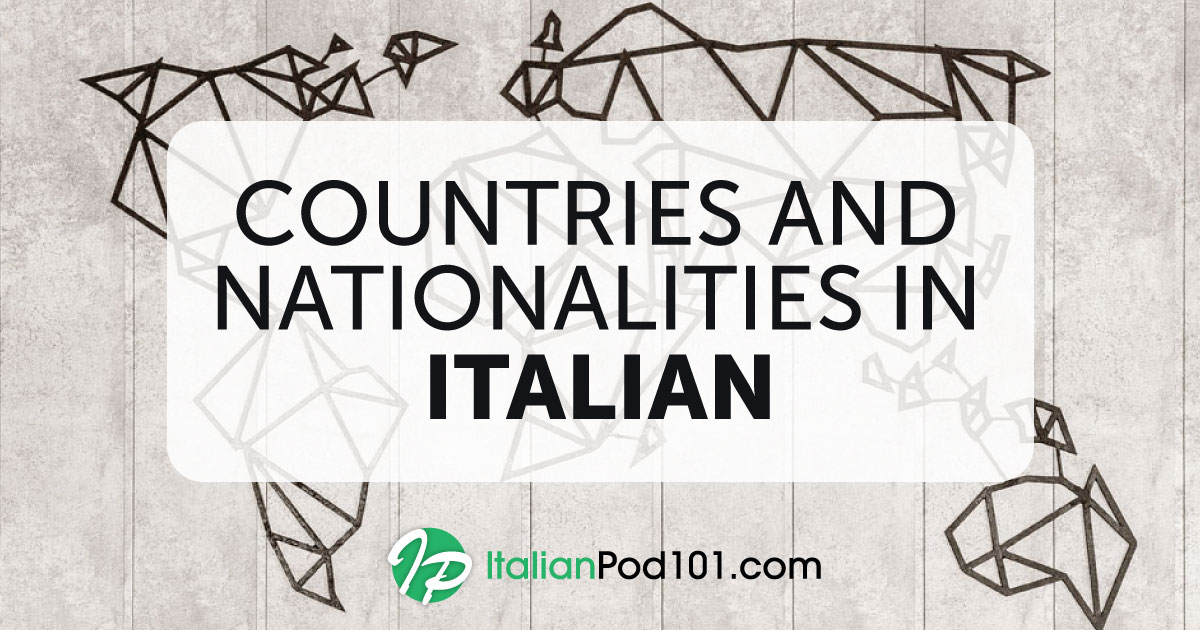
Do you want to make a good first impression on your new Italian friends or colleagues? Learning how to introduce yourself in Italian is definitely the very first skill that you’ll need in order to master that important first impression and to make new Italian friends.
So, let’s start with the very basic phrases you’ll need in order to introduce yourself in the Italian language.
- Ciao! (“Hello!”)
- Mi chiamo… (Literally “I’m called…”)
- Piacere di conoscerti! (“Nice to meet you”)
Introducing yourself in Italian is more than learning how to say correctly in Italian “Hello, my name is…” (Ciao, mi chiamo…). Of course, talking about your name in Italian is the very first stone upon which you build the entire self-introduction conversation.
But in order to establish a good rapport, you should master the typical Italian introduction phrases, and understand how to adapt the tone and content of the introduction according to the person you’re meeting, whether it’s a social or a professional encounter, a formal or informal setting.
Any time you meet an Italian for the first time at a party, a business meeting, a job interview, or a date, you’ll need to know how to say who you are and where you come from, as well as give information about yourself that’s relevant to the context you’re in.
Now, there are different ways to introduce yourself in Italian based on context and who you’re speaking to.
Table of Contents
- Formal vs. Informal Introduction
- Common Phrases to Introduce Yourself in Italian
- What Gestures Go with an Introduction?
- Italian Etiquette to Introduce Yourself
- Ask Questions and Describe Yourself in Italian
- Making Friends: How to Introduce Someone in Italian
- How to Talk About Yourself in Italian
- How to Introduce Yourself During a Business Meeting
- How ItalianPod101 Can Help You Learn More Italian
1. Formal vs. Informal Introduction:
The very first step is to know whether to use the formal address (dare del Lei) or the informal address (dare del tu). So, what’s the basic rule of thumb to know when to use one or the other? Basically, you use the formal phrase with people that you don’t know, people who are older than you, people in a hierarchical higher position than you (a teacher, a policeman, a judge), etc.
How does it work?
| Action | Informal | Formal |
|---|---|---|
| Greeting | Ciao! | Buongiorno/Buonasera! |
| Gesture | Kiss | Handshake |
| Pronoun | Tu | Lei (3rd person feminine) |
| Verb | Piacere di conoscerti | Piacere di conoscerla |
While in the past these rules were rather strict, and no one dared to use the informal tu unless it was with close friends and family, nowadays it’s more and more common to use the informal phrase among young people and those who aren’t so young. In certain professional environments, for example in new economy firms, tech industries, fashion, etc., it’s also becoming quite common to use the informal tu right away.
When in Doubt…
When in doubt, start with the formal. Also, a good practice is to ask beforehand if it’s okay to use the informal address:
- Posso darti del tu? “Can I use informal address?”
- Possiamo darci del tu? “Can we use informal address?”
And don’t worry, Italians are aware that the formal way of addressing people is a bit complicated for foreigners, so they always accept the use of tu with no grudges… 😉
2. Common Phrases to Introduce Yourself in Italian
To introduce yourself in Italian, you’ll need to know the basic phrases, always keeping in mind the difference between formal and informal as well as the difference between social and professional contexts. So…

1- Start with a Greeting:
Normally, you start introducing yourself by greeting the other person with an informal “hello” (ciao) or with “nice day/nice night” (buongiorno/buonasera). Wait… when do you say each of these Italian greeting phrases? There’s no written rule, but you should use buongiorno until the middle of the afternoon, and buonasera from when it starts to get dark. And note that buongiorno/buonasera can actually be used both in formal and informal introductions.
2- Say Your Name:
Talking about your name in Italian is a skill you really can’t get around learning—it’s vital, as in any language. There are a few ways to tell who you are and what your name is in Italian. Let’s see them together:
- Mi chiamo Maria Rizzo (literally, “I am called…”)
- Sono Maria Rizzo (“I am…”)
- Maria Rizzo (Simply state your name)
Depending on the context, Italians introduce themselves by saying simply their first name or saying their first name and last name. For example, if you’re at a party, or among a group of young people, it’s okay to just say your first name. However, in more formal settings such as during a business meeting, Italians expect you to say your last name.
These three are all perfectly acceptable ways to say your name in Italian. In some situations, you might want to specify who you are in that context. For example:
- At a wedding, you can add: Sono Maria Rizzo, un’amica della sposa (“I am a friend of the spouse”).
- In formal professional environments, you just say your last name (cognome) and your function or area: Rizzo, Responsabile Creativo (“Rizzo, I’m in charge of creation”).
And let’s not forget to ask everybody else’s name too:
- E tu come ti chiami? (“What is your name?”)
- E Lei come si chiama? (“What is your name?”) [Formal]
3- Express Pleasure to Meet Them:
After you’ve told everyone what your name is in Italian and have collected their name too, it’s expected that you express how happy you are to meet them. To do so, you want to use one of the following common expressions:
- Piacere/Molto piacere! (“My pleasure!”)
- Piacere di conoscerti (“Pleasure to meet you”)
- Piacere di conoscerla (“Pleasure to meet you”) [Formal]
- Molto lieto (“Very glad”)
- Lieto di conoscerla (“Glad to meet you”)
They all basically mean the same thing, except the last two phrases which sound just a bit old-school.
3. What Gestures Go with an Introduction?
Introducing yourself in Italian is about more than words and grammar. Gestures are very important for Italians, so when you’re introducing yourself in Italian to a friend or a colleague, it’s common to show through your gestures that you’re glad to meet them and that you want to show closeness. So, you can start by showing a nice smile (un bel sorriso). Make eye contact and give a firm handshake (una stretta di mano) to show that you’re genuinely interested in meeting with them.
Sometimes when introducing themselves, Italians might offer a kiss on the cheek (un bacio sulla guancia), one or two, but only in very informal settings. And sometimes a simple nod of the head will show that you acknowledge the other person and that you’re happy to make their acquaintance.
4. Italian Etiquette to Introduce yourself
According to the Galateo (the Rules of Polite Behavior published in Florence in 1558), there’s a proper etiquette to introduce yourself which include, among others, taking your hat off and doing a baciamano (a very light kiss on the hand) if you’re a man, remaining seated if you’re a woman, taking off your gloves to shake hands, and, generally, wait for someone else to introduce you.

Needless to say, many things have changed from the Renaissance and nowadays it’s very uncommon to receive a baciamano, and men don’t wear hats very often. But some basic rules still apply and they can help you when you want to introduce yourself to an Italian.
5. Ask Questions and Describe Yourself in Italian
Okay, now you have the basics covered: You already have said “Hello, my name is…” (Ciao, mi chiamo…), and you’ve shaken hands, smiled, nodded, and expressed happiness about meeting your new Italian friend or colleague. Now it’s time to describe yourself in Italian. You might want to start by saying where you’re from and where you live.

1- Di dove sei? (“Where are you from?”)
When meeting with a foreigner, usually one of the first questions you’ll ask is where they’re from. So, they might ask you:
- Di dove sei? (“Where are you from?”)
- Di che città/paese sei? (“What city/country are you from?”).
Good answers include:
- Sono di... (“I am from…”)
- Vengo da Londra/dall’Inghilterra (“I come from London/England”)
- Sono Inglese (“I am English”)
At this point, to know more about the other person, you want to ask what Italian city your new friend is from. Remember that, although Italy is a fairly small country, because of its cultural richness, every city has distinctive peculiarities and Italians are very fond of their local heritage! So, go ahead and ask:
- E tu, di che città sei? [Informal] or E lei, di che città è? [Formal] (“And you, what city are you from?”)
- Dove vivi? [Informal] or Dove vive? [Formal] (“Where do you live?”)
2- Da quanto tempo? (“How long…?”)
If you’ve been living in a city, studying Italian, or traveling through Europe, these are all interesting pieces of information to share when you’re introducing yourself in Italian. And you might want to specify for how long you’ve been doing it. Here are a couple of examples of introducing yourself in Italian by asking/answering this question:
-
- Da quanto tempo vivi a Roma?
(“How long have you been living in Rome?”) - Vivo a Roma da 4 settimane. (“I have been living in Rome for four weeks.”)
Or
- Da quanto tempo studi l’italiano? (“How long have you been studying Italian?”)
- Studio l’Italiano con ItalianPod101 da 6 mesi! (“I have been studying with ItalianPod101 for six months!”)
3- Quanti anni hai? (“How Old are You?”) — Use with Caution
Now, this is a question you don’t want to ask older people or to Italian women, and it’s generally not asked during introductions. The only acceptable scenario in which to ask about someone’s age is among teenagers when a few years makes a lot of difference in social status! 😉
And if you’re in a professional setting, asking an Italian their age is even considered discriminatory in some cases. So it’s a big no-no. But you can always volunteer your age, and your friends will probably do the same: Ho 38 anni. E tu? (“I am thirty-eight. And you?”).
A smooth way to introduce the age factor in a conversation is to compare ages with phrases like these:
- Abbiamo più o meno la stessa età. (“We are more or less the same age.”)
- Sei più giovane di me, vero? (“You’re younger than me, right?”)
- Io sono sicuramente più grande di te. (“I am definitely older than you.”)
4- Di cosa ti occupi? (“What do you do?”)
Until the past century, it wasn’t considered polite to talk about jobs and professions when meeting socially. Now, this has definitely changed, and it’s more and more common nowadays during Italian introductions to ask about each other’s profession. Especially if it’s a social encounter where people are doing networking.When talking about your job in Italian, these are a few useful phrases to know:
- Di cosa ti occupi? (“What is your area?”)
- Che lavoro fai? (“What is your job?”)
- Che cosa fai? (“What do you do?”)
And to answer these questions with your profession, you just need to say Sono… (“I am…”) and your profession. Very simple:
- Sono insegnante. (“I am a teacher.”)
- Sono operaio. (“I am a factory worker.”)
- Sono dottore. (“I am a doctor.”)
But whatever you do, don’t ever ask about money. It’s considered vulgar and rude. 😉
6. Making Friends: How to Introduce Someone in Italian
Imagine a scenario where you’re with your friends and you meet an Italian acquaintance. At this point, you already know the basics of introducing yourself in Italian and you’re ready to try and introduce your friends. Here are some simple phrases to do it:
- Ti presento Gabriele. (“I introduce you to Gabriele.”)
- Posso presentarti Anna? (“May I introduce you to Anna?”)
- Lui/Lei è… (“He/She is…”)
- Conosci Marco? (“Do you know Marco?”)
7. How to Talk about Yourself in Italian

After the basic introduction is when you really start getting to know each other and becoming friends. So now it’s time to talk more about you, your family, your pets, your hobbies, and much more.
If you’re a student, you want to specify what your areas of study are, for example: Sono studente, studio letteratura (“I am a student, I study literature”).
And don’t be shy, you also want to add something about your personality, such as:
- Sono timido (“I am shy”)
- Sono allegra (“I am happy”)
- Sono sportivo (“I like sports”)
- Sono ottimista (“I am an optimist”)
Here are some phrases for talking about your family in Italian:
- Ho due fratelli (“I have two brothers”)
- Non ho sorelle (“I have no sisters”)
- Sono figlia unica (“I am an only child”)
Then you can start talking about your hobbies in Italian and what you like to do in your spare time:
- Mi piace giocare a calcio (“I like to play soccer”)
- Mi piace leggere (“I like to read”)
- Mi piace cucinare (“I like to cook”)
Your new friends are probably also interested in knowing if you have any pets. Here are some phrases for talking about your pets in Italian:
- Hai animali domestici? (“Do you have any pets?”)
- Ho un gatto (“I have a cat”)
- Ho un cane che si chiama Ugo (“I have a dog called Ugo”)
- Ho un acquario (“I have a fish tank”)
And finally, you can ask about spoken languages:
- Che lingue parli? (“What languages do you speak?”)
- Parlo Inglese, Francese, Italiano e Korean (“I speak English, French, Italian, and Korean”)
8. How to Introduce Yourself During a Business Meeting
Most of the previous information applies rather to a social gathering and they’re not very appropriate in the case of an introduction in a professional setting or in a job interview. Throughout the article, you’ve already learned various tips about introducing yourself in a professional setting, but it’s important to go deeper into them here:
- Use the formal way of addressing (Lei) unless someone proposes dare del tu.
- A smile, a nod, and a handshake. No kisses.
- Use first name and last name to introduce yourself. Or just the last name.
- Say where you’re from, your nationality, what languages you speak, what you’ve studied and where, and what your area of expertise is.
9. How ItalianPod101 can Help You Learn More Italian
We hope that you’ve learned by now how to introduce yourself in Italian and start a simple conversation with your new Italian friends and colleagues. You should also take a look at this ItalianPod101 lesson: here you’ll be able to listen to the audio and practice your pronunciation of the top ten Italian phrases that you’ll definitely need for introducing yourself in Italian. So, now you’re ready to make new Italian friends and to talk about yourself in Italian.
Thank you, and keep having fun learning Italian! Hopefully this lesson on introducing yourself in Italian proved very helpful to you. 🙂















